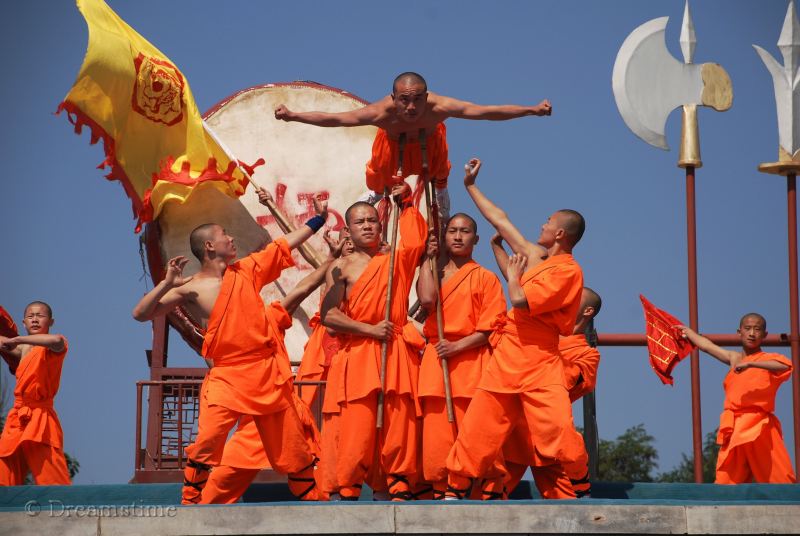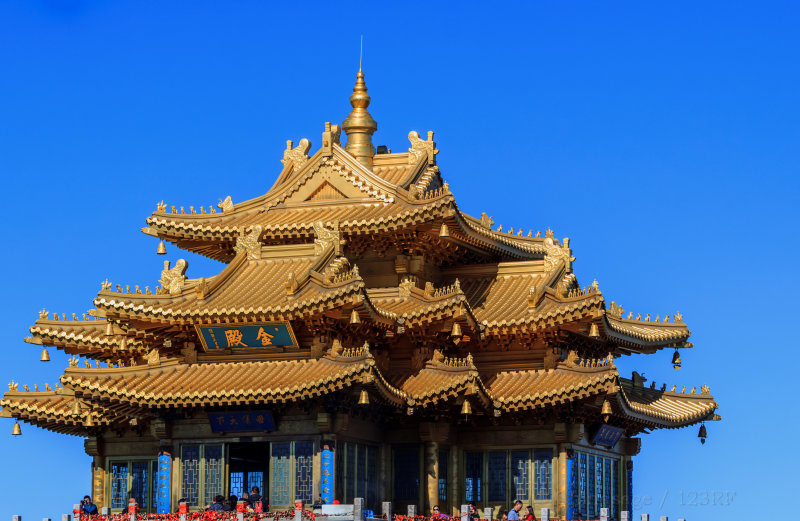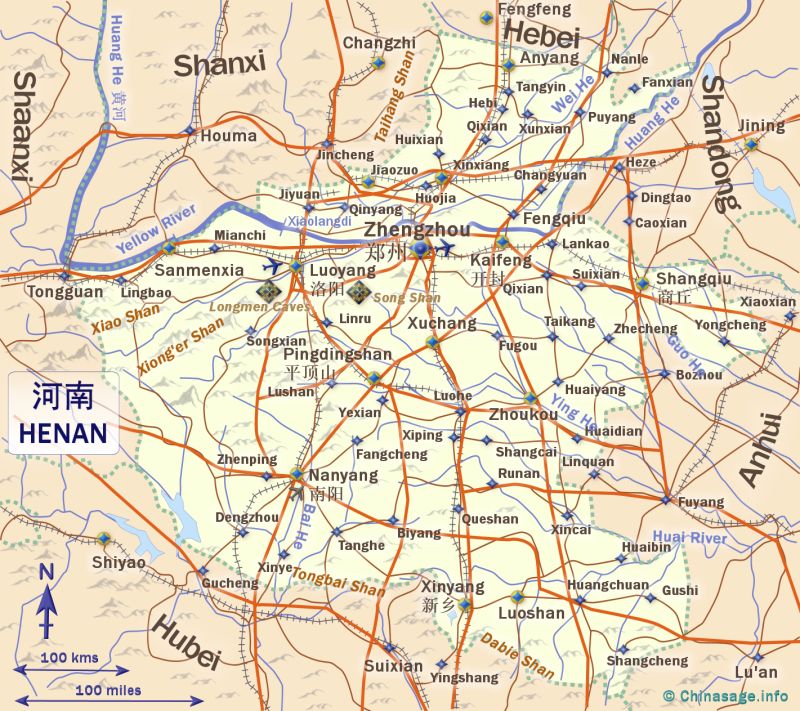Henan, China

| Province | Hé nán 河南 'river south' |
| Short name | 豫 Yù |
| Capital | Zhengzhou |
| Population | 99.366 million (7.03%) [3rd] comparison table |
| Area | 167,000 km2 [64,479 mile2] (1.74%) [17th] |
| GDP | 55,348 (21.98%) [20th] |
| Neighbors | Shanxi Shaanxi Hubei Hebei Shandong Anhui |
| Others | or just click on the map |

Image by PericlesofAthens ➚ available under a Creative Commons license ➚
Straddling the Yellow River that was the birthplace of Chinese civilization, Henan is an ancient province, within it are two of the ancient capitals of China: Luoyang and Kaifeng. Mountains to the west and center separate the Yellow River from the southeastern area (the Nanyang plain) which is drained by the Huai River. Floods from both the Yellow and Huai Rivers have punctuated Henan's long history. Henan built cities right back in the Shang dynasty (1600 - 1046 BCE) with its capital at Jenshih (Anyang) just west of Zhengzhou. The meandering Yellow River in ancient times followed a course further north near to Anyang. Remains from even earlier, one of the earliest world civilizations - the ancient Yangshao Culture ➚ can be seen at a museum near Mianchi.
The modern provincial capital of Zhengzhou is on the site of an ancient Shang city called ‘Ao’ active around 13th century BCE. The coming of railways made Zhengzhou an important center and it has greatly expanded since 1949. Henan was one of the areas worst affected by the Great Leap Forward policy of Mao Zedong. Henan is the second most populous province with just over 100 million people. Favorable soil and climate make Henan a region of rich harvests, although nowadays it has become heavily industrialized.


Luoyang - ancient capital
Luoyang just south of the river was the ancient capital of China for 13 dynasties before it was sacked by Jurchen invaders in 937CE. The philosopher Laozi is one of the many great figures associated with the city. It is sometimes known as the ‘eastern Imperial city’ but has few remaining ancient buildings after centuries of plunder. The city museum's has many fine exhibits of Luoyang's days of pre-eminence. There is an annual Peony Festival which was brought into being by famous Tang Empress Wu Zetian. Baimasi (White Horse Temple) at Luoyang claims to be the oldest Buddhist monastery in China dating back to 68CE; the name comes from the legend that it was founded by two monks who arrived on a white horse. Luoyang has grown far beyond its ancient limits and is a modern industrialized city.

The Longmen Caves ➚ (‘Dragon Gate’), 7 miles [12 kms] south-west of Luoyang in Henan has a fine set of Buddhist carved figures dating back to the Wei and Tang dynasties (500-900CE). There are over 1,300 grottoes with nearly 100,000 Buddhist statues of all sizes. Of particular interest are the inscriptions in the ‘Grotto of Prescriptions’ which gives 120 recipes for herbal medicines. Tang Empress Wu Zetian had the famous vast seated Buddha 56 feet [17 meters] erected here. Many of the sculptures are damaged, the damage began when Buddhism fell out of favor in the late Tang dynasty and more recently during the Cultural Revolution when anything ‘old’ came under attack. Longmen Caves provides evidence of China's long excellence in porcelain manufacture at the Jun Royal Kiln ➚, Xuchang which dates back to Song dynasty times. The area also contains the tomb of the Tang poet Bai Juyi.


Kaifeng - ancient capital
Kaifeng, Henan became the capital city after Luoyang was abandoned and was at its zenith up until the invasion of the Mongols during the Song dynasty when it was looted and laid waste. One of the most famous scrolls in China ‘Going up river at Qingming Festival’ shows a very detailed and accurate portrayal of life at Kaifeng in its heyday. Subject to periodic flooding many historic buildings of that time have been swept away leaving very little trace. There is a viewing platform where the nearby surging Yellow River can be seen. The path of the Yellow River has changed greatly over time, only a few centuries ago it flowed south-east reaching the sea to the south of Shandong.
The ‘Shanshan Gan Guildhall’ is a heavily decorated Qing dynasty hall built by merchants. The Prime Minister's Temple (Da Xiangguo Si ➚) has been rebuilt on the site of the main Buddhist temple in the Song capital city. It is most famous for a large statue of the Buddhist Goddess Guanyin. Longting Park has been built in the Song dynastic style to the delight of tourists. More authentic is the Fan pagoda ➚ located south of the city which dates back a thousand years.
It was at Kaifeng that the Yellow River's levees have been deliberately breached, once in 1644 to unsuccessfully hold back the invading Manchu and again in 1938 ➚ when Chiang Kaishek flooded the land to impede the Japanese invasion, killing one million Chinese ➚ people in the process. A great flood in 1841, at the time of the first Opium War, led to many deaths as the whole city was submerged in waters for many weeks. The city is also renowned for a small isolated community of Jews who settled at Kaifeng hundreds of years ago. The Iron Pagoda ➚ (made of rust colored bricks rather than iron) is another interesting tourist site reflecting its ancient heritage.
Near Kaifeng is the Baogong Temple ➚ built in memory of Bao Zheng renowned for his fair administration of justice. Guanlin Temple ➚ commemorates Guan Yu of the Three Kingdoms period who was worshiped as the ‘God of Righteous Action’. The Dragon Pavilion ➚ at Kaifeng is another ancient temple.
Song Shan - sacred mountain
The sacred mountain of Songshan ➚ is a famous scenic site south east of Luoyang. At 4,902 feet [1,494 meters] it stands as an impressive peak with scary, precipitous paths leading to the summit. The Temple of Songshan is the oldest stone pagoda in China as it dates back to Northern Wei times (523CE). The Daoist ‘Temple of the Central Mountain’ is older but has been rebuilt over the centuries since its foundation in Han times. On the foothills of Mount Song is the Gaocheng Observatory ➚, a World Heritage site, dating back to the Yuan dynasty which recorded accurate astronomical observations for many centuries. A gnomon ➚ was erected here in the Tang dynasty to help measure the circumference of the Earth (the ancient 'li' a unit of distance was derived from this). It allows for very accurate measurement of shadows and from this the date and length of the year. The measurements were not surpassed in Europe for hundreds of years. The main observatory was restored in the Ming dynasty. Songyang Academy has two ancient cypresses called the Lesser and Greater Generals believed to date back two thousand years and named by Han Emperor Wudi in 110BCE.

Close to Mount Song is the world famous Shaolin monastery ➚ (literally ‘Small Forest Temple’) immortalized by the ‘Kung Fu ➚’ series of the 1970s. It is a Zen Buddhist temple and dates back to the Wei dynasty when Indian Da Mo ➚ founded the monastery and instigated the Wushu martial art. Nearby is the Pagoda Forest (Ta Lin) of 200 tombs dating back as far as the Tang dynasty. The tombs of the early Song dynasty emperors are close by at Songshan, between Zhengzhou and Luoyang. Not much remains now apart from the statues marking the Sacred way to the tombs.


Anyang
Anyang is the most ancient of the cities in Henan, it is built on the remains of the Shang dynasty capital of Yin. There is a museum housing many remains from this period including the oracle bones inscribed with early Chinese characters. Nearby is the tomb of Yuan Shikai, the 'Republican' marshal who tried to found a new dynasty in 1915.
Near Anyang is a more recent achievement of human labor, the Red Flag Canal ➚. It was built between 1960-1974 with the same large scale use of labor as the Great Wall, it provides irrigation and transportation in the arid northern part of Henan.

Zhengzhou
The modern, provincial capital of Henan is Zhengzhou which has only a few old buildings but does have an extensive provincial museum. Yellow River Park to the northwest gives good views of the Yellow river. Zhengzhou has an annual Martial Arts Festival every September.
Sanmenxia and Xiaolangdi Dams
Henan has two dams that have tried to tame the destructive power of the Yellow River. The Sanmenxia dam was built in the 1950s with Russian help and has not been very successful. More recently the Xiaolangdi dam was constructed that has proven much more effective.
Airports
The airport has 2 terminals and is located 18.6 miles (30.0 kms) from Zhengzhou. Live Flight information ➚, rank in China 16
See map of location Zhengzhou Xinzheng International Airport
The airport has 1 terminal and is located 9.3 miles (15.0 kms) from Luoyang. Live Flight information ➚, rank in China 82
See map of location Luoyang Beijiao Airport

Google map of Henan
Bing map of Henan ➚
Show Bing Map ➚
Henan Climate

| Major Cities | Population | |
|---|---|---|
| Anyang | 安阳 | 1,146,839 |
| Hebi | 鹤壁 | 244,662 |
| Jiaozuo | 焦作 | 517,540 |
| Kaifeng | 开封 | 900,000 |
| Luohe | 漯河 | 417,356 |
| Luoyang | 洛阳 | 2,372,571 |
| Nanyang | 南阳 | 251,532 |
| Pingdingshan | 平顶山 | 889,675 |
| Puyang | 濮阳 | 760,300 |
| Sanmexia | 三门峡 | 669,307 |
| Shangqiu | 商丘 | 181,218 |
| Xinxiang | 新乡 | 1,047,088 |
| Xinyang | 信阳 | 1,590,668 |
| Xuchang | 许昌 | 1,265,536 |
| Zhengzhou | 郑州 | 6,650,532 |
| Zhoukou | 周口 | 377,061 |
Book: 60 Scenic Wonders in China: New World Press: 1980 pp. 137-142
Book: A Map History of Modern China: Catchpole: Heinemann: 1976 pp. 4-6
Book: China : A short cultural history: C.P. Fitzgerald: The Cresset Press: 1950 p. 24
Book: China : Eyewitness Travel: Dorling Kindersley: 2012 pp. 46, 150-159
Book: History: China Handbook Series: Foreign Languages Press: 1982 pp. 1-12
Book: Insight Guides: China: APA publications: 1994 pp. 211-215
Web page: Book: Larousse Encyclopedia of the World: Hamlyn: 1964 ➚ p. 520
Book: Lonely Planet: China: 1988 pp. 249-264
Book: Modern China: A companion to a rising power: Graham Hutchings:… pp. 189-190
Book: Nagel's Encyclopedia guide: China: Nagel: 1978 pp. 778-831
Web page: Henan (wikitravel) ➚
Web page: Henan Tourist Guide - Cradle Of Chines Kungfu ➚
Web page: Map of Henan Province and travel guide ➚
City populations for 2012, Province statistics National Bureau of Statistics 2014